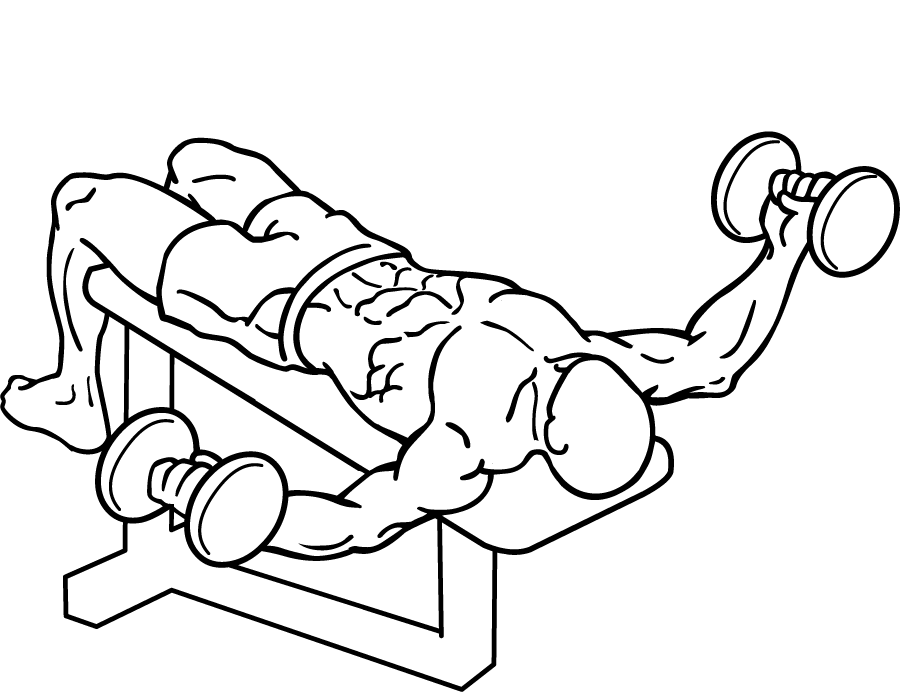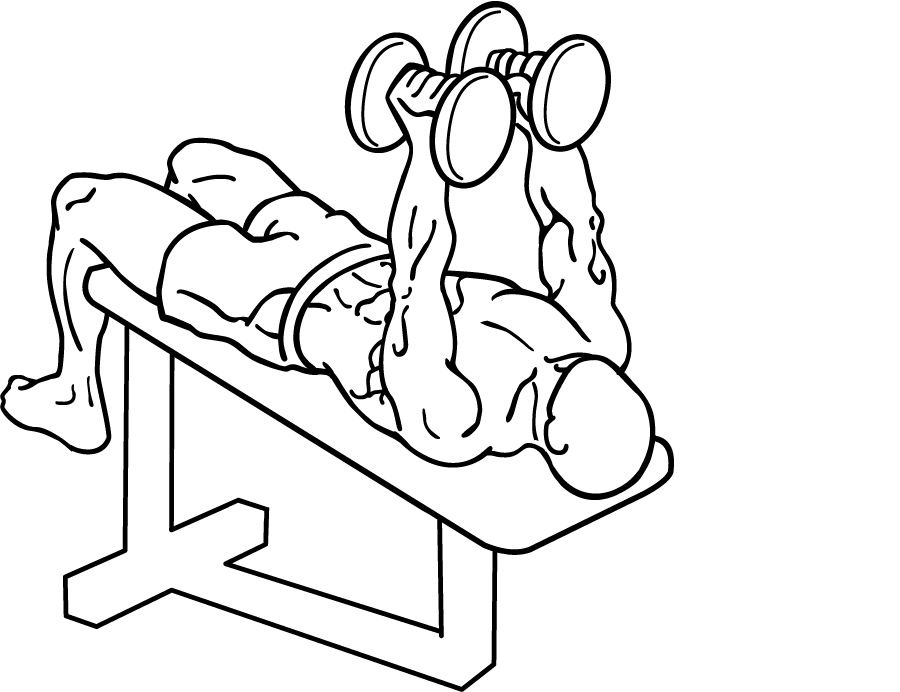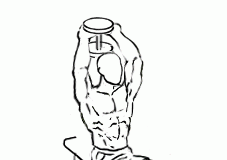Last Updated on September 30, 2022
The decline dumbbell flyes is a powerful isolation exercise designed to target and strengthen the chest (pectorals) and shoulders. Unlike pressing movements that involve pushing a weight away from the body, flyes focus on stretching and contracting the chest muscles through a wide range of motion, helping to build size, definition, and flexibility in the upper body.
Performed on a decline bench, this variation of the dumbbell fly shifts the emphasis to the lower portion of the chest, helping to create a fuller, more balanced chest. The decline angle also engages the anterior deltoids (the front part of the shoulders), making this exercise an effective addition to any chest or upper body routine.
In this comprehensive guide, we’ll dive into the benefits of decline dumbbell flyes, break down the proper technique, explore common mistakes to avoid, and offer tips on how to integrate this exercise into your workout for maximum results.
What Are Decline Dumbbell Flyes?
Decline dumbbell flyes are an isolation exercise performed on a decline bench, where the head is positioned lower than the feet. This exercise is unique in that it focuses primarily on stretching and contracting the chest muscles rather than pushing or pulling heavy weights. The decline angle of the bench targets the lower portion of the chest more intensely, helping to develop a well-rounded chest.
During the movement, your arms move in an arcing motion, mimicking the natural range of motion of the chest muscles. This allows for a deeper stretch and contraction compared to other chest exercises, such as the flat bench press or incline flyes. By focusing on the lower chest, decline dumbbell flyes complement other exercises that target the upper and middle parts of the chest.
Muscles Worked During Decline Dumbbell Flyes
This exercise primarily targets the chest muscles, but it also engages the shoulders and other supporting muscles for stability. Here’s a closer look at the muscles worked:
- Pectoralis Major (Chest): The main muscle worked during the decline dumbbell fly is the lower portion of the pectoralis major. The fly motion helps stretch and contract the chest muscles, leading to muscle growth and definition.
- Anterior Deltoids (Shoulders): The front of the shoulders is activated to stabilize the movement and assist in controlling the descent and lift of the dumbbells.
- Serratus Anterior: This muscle, located on the sides of your ribcage, helps stabilize your shoulders and plays a supporting role during the wide range of motion in the fly.
- Core Muscles: Although this is not a primary core exercise, the decline position requires your core muscles to stay engaged to stabilize your body throughout the movement.
Benefits of Decline Dumbbell Flyes
Decline dumbbell flyes offer a range of benefits that make them a valuable addition to any chest or upper body workout. Here are some of the key advantages:
- Targeted Lower Chest Development: The decline angle shifts the focus to the lower portion of the chest, an area that can often be underdeveloped compared to the upper and middle chest. This helps create a more balanced and aesthetic chest appearance.
- Improved Muscle Flexibility: The wide range of motion in the fly movement allows for a deep stretch of the chest muscles, improving flexibility and mobility in the upper body.
- Enhanced Muscle Definition: Flyes are a great exercise for isolating the chest muscles, which can lead to better muscle definition and tone, especially when combined with pressing movements like the bench press.
- Minimal Joint Stress: Unlike some pressing exercises that can place strain on the shoulders, decline dumbbell flyes are a low-impact movement that reduces stress on the joints while still providing an effective chest workout.
- Better Mind-Muscle Connection: Because flyes emphasize slow, controlled movement and stretching, they help you develop a better connection with your chest muscles. This enhanced mind-muscle connection can improve your ability to target specific muscles during other chest exercises.
- Increased Chest Engagement: Unlike the flat or incline bench press, which can sometimes shift focus to the triceps or shoulders, decline dumbbell flyes place the majority of the work on the chest muscles, making it an ideal exercise for isolating the chest.
Proper Technique for Decline Dumbbell Flyes
Performing decline dumbbell flyes with proper form is essential for maximizing their effectiveness and minimizing the risk of injury. Follow these steps to ensure you’re performing the exercise correctly:
- Set up the decline bench: Begin by adjusting the bench to a decline angle, typically between 15 to 30 degrees. Ensure the bench is stable, and your feet are firmly secured under the footpads.
- Grab the dumbbells: Select a pair of dumbbells that you can control throughout the exercise. Start with lighter weights to perfect your form before moving on to heavier loads. Sit on the bench and lie back with the dumbbells resting on your thighs.
- Position the dumbbells: Once you’re lying on the bench, bring the dumbbells together above your chest. Your arms should be extended but with a slight bend in your elbows to protect your joints and maintain tension in your chest.
- Lower the dumbbells: Slowly lower the dumbbells in a wide, arcing motion out to the sides of your body, keeping your elbows slightly bent. Lower the dumbbells until they are level with your chest or just above your shoulders, making sure to feel a deep stretch in your chest.
- Pause and feel the stretch: At the bottom of the movement, pause briefly and focus on the stretch in your chest muscles. This pause helps maximize muscle activation and ensures you’re not using momentum to lift the weights.
- Return to the starting position: Using your chest muscles, bring the dumbbells back to the starting position in the same wide, arcing motion. Keep the movement slow and controlled to ensure proper muscle engagement. Do not let the dumbbells touch at the top; instead, stop just before they meet to keep tension on your chest.
- Repeat: Perform the desired number of repetitions, typically 3 to 4 sets of 8 to 12 reps, depending on your fitness level and goals.
Common Mistakes to Avoid
To get the most out of the decline dumbbell fly and reduce the risk of injury, avoid these common mistakes:
- Using Too Much Weight: One of the most common mistakes is lifting too heavy, which can compromise your form and increase the risk of shoulder strain. Start with a lighter weight that allows you to maintain control throughout the movement.
- Bending the Elbows Too Much: If your elbows bend too much during the exercise, it turns into more of a press than a fly, reducing the effectiveness of the movement. Keep a slight bend in your elbows, but avoid turning it into a pressing motion.
- Not Controlling the Descent: Letting the dumbbells drop too quickly reduces the time under tension and increases the risk of injury. Focus on lowering the weights slowly and with control to maximize the stretch and muscle engagement.
- Allowing the Dumbbells to Touch: At the top of the movement, avoid letting the dumbbells touch each other. Bringing them together can release the tension in your chest, reducing the effectiveness of the exercise. Stop just before they meet to keep your chest engaged.
- Arching the Lower Back Excessively: While a slight arch in your lower back is natural during this exercise, excessive arching can strain your lower back. Engage your core to keep your spine neutral throughout the movement.
- Flaring the Elbows: Keeping your elbows locked or flaring them out too far can place unnecessary stress on your shoulder joints. Keep a slight bend in the elbows to protect your joints while ensuring the chest muscles do most of the work.
Variations of Decline Dumbbell Flyes
Once you’ve mastered the standard decline dumbbell fly, you can try these variations to keep your workouts fresh and challenging:
- Flat Bench Dumbbell Fly: Perform the same movement on a flat bench to target the middle part of the chest. This is a great variation for adding variety to your chest routine.
- Incline Dumbbell Fly: Use an incline bench to focus on the upper portion of the chest. This variation complements the decline fly and helps you develop a well-rounded chest.
- Cable Flyes: Use cables instead of dumbbells for a different type of resistance. Cables provide constant tension throughout the movement, which can increase muscle activation and promote better growth.
- Single-Arm Dumbbell Fly: Perform the exercise with one arm at a time. This variation increases the challenge by forcing each side of your body to work independently, improving balance and muscle coordination.
How to Incorporate Decline Dumbbell Flyes into Your Workout Routine
The decline dumbbell fly is a versatile exercise that can be easily integrated into any upper body or chest-focused workout. Here’s how to incorporate it effectively:
- Frequency: Include decline dumbbell flyes in your chest workouts 1 to 2 times per week, depending on your training split.
- Reps and Sets: For muscle growth, aim for 3 to 4 sets of 8 to 12 reps. If you’re focusing on muscle endurance, go for 12 to 15 reps with lighter weights.
- Pair with Pressing Movements: Combine decline dumbbell flyes with pressing exercises such as the decline or incline bench press, or chest dips, for a well-rounded chest workout.
- Rest Between Sets: Allow 60 to 90 seconds of rest between sets to ensure your muscles recover adequately while maintaining intensity during the workout. This helps you keep the focus on form and muscle engagement without losing momentum.
Sample Decline Dumbbell Fly Workout Routine
To help you incorporate decline dumbbell flyes into a balanced chest workout, here’s a sample routine that targets the chest, shoulders, and triceps:
- Warm-Up (5-10 minutes)
- Light cardio (e.g., treadmill or jump rope) to get the blood flowing
- Dynamic stretches, focusing on the chest, shoulders, and triceps
- Workout:
- Decline Dumbbell Bench Press – 4 sets of 8-10 reps
- Decline Dumbbell Flyes – 4 sets of 10-12 reps
- Incline Barbell Bench Press – 3 sets of 8-10 reps
- Cable Crossovers – 3 sets of 12-15 reps
- Chest Dips – 3 sets of 8-12 reps (focus on leaning forward to engage the chest)
- Push-Ups (as a burnout finisher) – 2 sets to failure
- Cooldown (5-10 minutes)
- Static stretches for the chest, shoulders, and arms to help improve flexibility and reduce soreness.
This workout combines various exercises to target the entire chest, including the lower chest with the decline movements. Pairing decline dumbbell flyes with pressing movements ensures a well-rounded and complete chest workout.
Is the Decline Dumbbell Fly Right for You?
The decline dumbbell fly is an excellent exercise for lifters at all experience levels, especially those looking to target and isolate the lower chest muscles. However, if you are new to strength training or have shoulder issues, it’s important to start with lighter weights and perfect your form before progressing to heavier loads.
For experienced lifters, decline dumbbell flyes can be a great tool to add more variety to your chest routine, helping to break through plateaus and further define the chest muscles. The exercise provides a stretch and contraction that is difficult to achieve with pressing movements alone, making it a valuable addition to your upper body training.
Final Tips for Success
- Start with Light Weights: Since the decline dumbbell fly requires control and precision, it’s best to start with lighter weights to master the movement. Gradually increase the weight as you become more comfortable with the form.
- Focus on Form: Proper form is key to getting the most out of this exercise. Always perform the movement slowly and with control, focusing on the stretch and contraction of the chest muscles rather than lifting heavy weights.
- Stay Consistent: Consistency is critical for muscle growth and definition. Incorporate decline dumbbell flyes into your regular chest workouts and track your progress over time to ensure you’re getting stronger.
- Use a Spotter: If you’re lifting heavier weights or working close to failure, consider using a spotter for added safety and assistance.
- Combine with Other Chest Exercises: To develop a balanced and strong chest, pair decline dumbbell flyes with other exercises such as flat or incline bench presses, push-ups, or chest dips.
The decline dumbbell fly is a must-have exercise for anyone looking to build a stronger, more defined chest. Its ability to isolate the lower chest muscles, while also engaging the shoulders and stabilizer muscles, makes it an effective and versatile exercise for both beginners and experienced lifters.
Keep challenging yourself, stay consistent, and in time, you’ll see the results in both strength and aesthetics!








